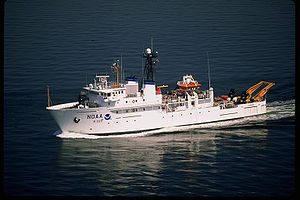NOAAS Ka'imimoana (R 333)
| 50px | It has been suggested that [[::USNS Titan (T-AGOS-15)|USNS Titan (T-AGOS-15)]] be merged into this article or section. (Discuss) |
 NOAAS Ka'imimoana (R 333) sometime between 1996 and 2009 | |
| Career (United States) | |
|---|---|
| Name: | Ka'imimoana |
| Namesake: | Ka'imimoana is a Hawaiian word meaning "Ocean Seeker" |
| Builder: | Halter Marine, Inc., Moss Point, Mississippi |
| Laid down: | 30 October 1986 |
| Launched: | 18 June 1988 |
| Completed: | 8 March 1989 |
| Acquired: | 31 August 1993 |
| Commissioned: | 25 April 1996 |
| Homeport: | Pearl Harbor, Hawaii |
| Status: | Active in NOAA Pacific Fleet |
| Notes: | Served in U.S. Navy Military Sealift Command as ocean surveillance ship USNS Titan (T-AGOS-15) 1988-1993 |
| General characteristics | |
| Type: | ex-U.S. Navy Stalwart-class oceanographic research ship |
| Tonnage: | 2,014 gross register tons; 604 net register tons |
| Displacement: |
1,650 tons (light) 2,301 tons (full load) |
| Length: | 224 ft (68 m) |
| Beam: | 43 ft (13 m) |
| Draft: | 15 ft (4.6 m) |
| Installed power: | 1,600 horsepower (2.1 megawatts) |
| Propulsion: | Diesel-electric: Two General Electric 800-horsepower (1.1-megawatt) diesel engines, twin fixed-pitch propellers, 116,000 gallons fuel; 550-horsepower (0.74-megawatt) Schottel bow thruster |
| Speed: | 10.5 knots (sustained) |
| Range: | 8,000 nautical miles (14,816 kilometers) |
| Endurance: | 30 days |
| Boats and landing craft carried: | One 22-foot (6.7-meter) rigid-hulled inflatable boat (RHIB); one 17-foot (5.2-meter) inflatable utility boat |
| Complement: | 20 (3 NOAA Corps officers, 1 U.S. Public Health Service Health Programs Officer, 3 licensed engineers, and 13 other crew) plus up to 12 scientists |
| Sensors and processing systems: | Deep-water echosounder, shallow-water echosounder, hull-mounted acoustic release transducer, navigation fathometer, X-band radar, S-band radar, Global Positioning System receivers, VHF radio direction finder, Sperry gyrocompass |
| Notes: | Welded steel, ice-strengthened hull |
NOAAS Ka'imimoana (R 333) is an oceanographic research ship in service with the National Oceanic and Atmospheric Administration (NOAA) since 1996.
Construction, acquisition, and commissioning
Ka'imimoana was laid down as the United States Navy Military Sealift Command Stalwart-class ocean surveillance ship USNS Titan (T-AGOS-15) on 30 October 1986 by Halter Marine, Inc. at Moss Point, Mississippi, and launched on 18 June 1988. Titan was delivered to the U.S. Navy on 8 March 1989. She was stricken from the Naval Vessel Register in 31 August 1993 and transferred to NOAA the same day.
The conversion of Titan into an oceanographic research ship began in May 1995 at the shipyard of Maritime Contractors, Inc., at Bellingham, Washington. Delivered to NOAA in April 1996 after completion of the conversion, the ship was commissioned into NOAA service as NOAAS Ka'imimoana (R 333) on 25 April 1996.
Capabilities
Ka'imimoana has berthing for 33 people in 21 single staterooms and six double staterooms providing her with the capacity to carry up to 12 scientists. She can seat 24 people at a time in two crew's mess rooms, eight in the forward room and 16 in the aft room. She has a medical treatment room with one bunk, overseen by a United States Public Health Service Health Programs Officer.
Ka'imimoana has 950 square feet (88 square meters) of laboratory space. On deck, she has a brailing winch, a CTD winch, three cranes, an A-frame, and a J-frame. She carries two boats, a 22-foot (6.7-meter) rigid-hulled inflatable boat (RHIB) as a rescue boat and a 17-foot (5.2-meter) inflatable utility boat. She is equipped with echosounders, a hull-mounted acoustic release transducer, a navigation fathometer, X-band and S-band radar, Global Positioning System receivers, a VHF radio direction finder, and a Sperry gyrocompass
Career
Ka'imimoana is home-ported at Pearl Harbor, Hawaii, and is the only NOAA ship dedicated solely to climate research. She supports NOAA's Tropical Atmosphere-Ocean Project, which is designed to improve understanding of the role of the tropical ocean in modifying the world's climate.
Ka'imimoana deploys, recovers, and services the National Data Buoy Center's deep-sea moorings -- which measure ocean currents, ocean temperatures, and atmospheric variables -- in the equatorial Pacific Ocean and transmits buoy measurements in real time to NOAA's Pacific Marine Environmental Laboratory in Seattle, Washington. She also continuously measures upper ocean currents, surface salinity, carbon dioxide content, and sea-level atmospheric conditions while underway.
References
- NOAA Marine Operations NOAA Ship Ka'imimoana
- NavSource Online: Service Ship Photo Archive T-AGOS-15 Titan NOAA Ka'Imimoana (R-333)
- Wertheim, Eric, ed. The Naval Institute Guide to Combat Fleets of the World, 15th Edition: Their Ships, Aircraft, and Systems. Annapolis, Maryland: United States Naval Institute Press, 2007. ISBN 978-1-59114-955-2. ISSN 1057-4581.
| ||||||||
